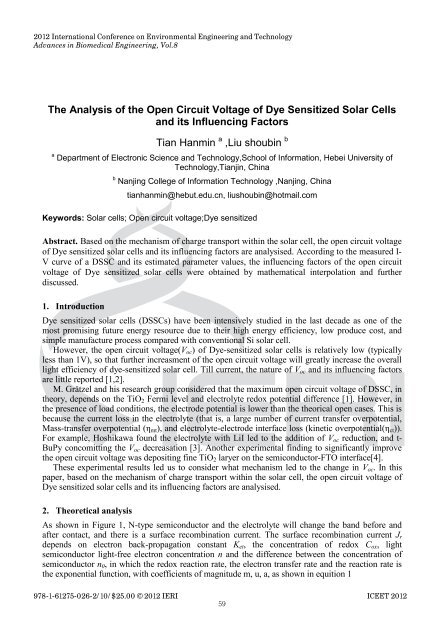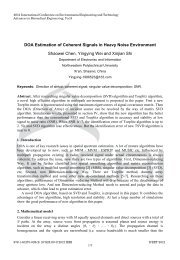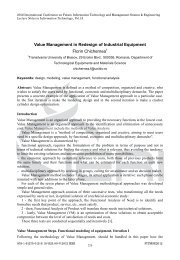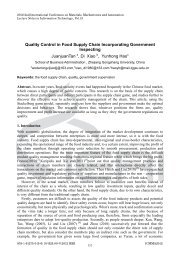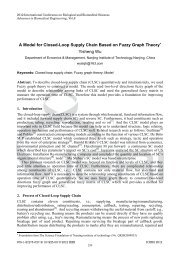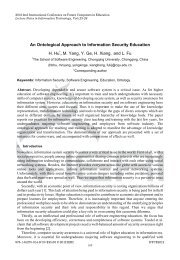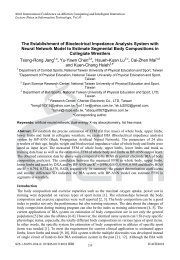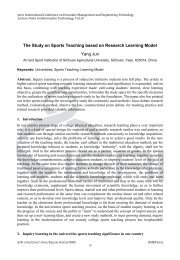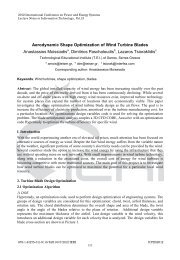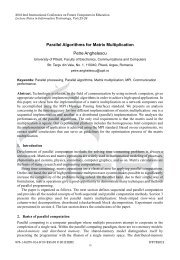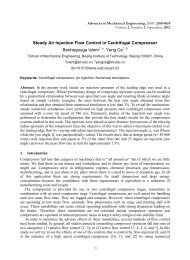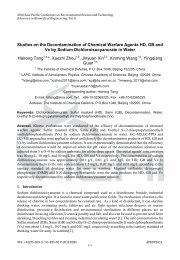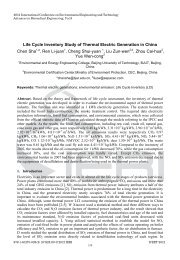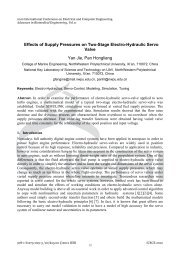The Analysis of the Open Circuit Voltage of Dye Sensitized Solar ...
The Analysis of the Open Circuit Voltage of Dye Sensitized Solar ...
The Analysis of the Open Circuit Voltage of Dye Sensitized Solar ...
You also want an ePaper? Increase the reach of your titles
YUMPU automatically turns print PDFs into web optimized ePapers that Google loves.
2012 International Conference on Environmental Engineering and Technology<br />
Advances in Biomedical Engineering, Vol.8<br />
<strong>The</strong> <strong>Analysis</strong> <strong>of</strong> <strong>the</strong> <strong>Open</strong> <strong>Circuit</strong> <strong>Voltage</strong> <strong>of</strong> <strong>Dye</strong> <strong>Sensitized</strong> <strong>Solar</strong> Cells<br />
and its Influencing Factors<br />
Tian Hanmin a ,Liu shoubin b<br />
a Department <strong>of</strong> Electronic Science and Technology,School <strong>of</strong> Information, Hebei University <strong>of</strong><br />
Technology,Tianjin, China<br />
b Nanjing College <strong>of</strong> Information Technology ,Nanjing, China<br />
tianhanmin@hebut.edu.cn, liushoubin@hotmail.com<br />
Keywords: <strong>Solar</strong> cells; <strong>Open</strong> circuit voltage;<strong>Dye</strong> sensitized<br />
Abstract. Based on <strong>the</strong> mechanism <strong>of</strong> charge transport within <strong>the</strong> solar cell, <strong>the</strong> open circuit voltage<br />
<strong>of</strong> <strong>Dye</strong> sensitized solar cells and its influencing factors are analysised. According to <strong>the</strong> measured I-<br />
V curve <strong>of</strong> a DSSC and its estimated parameter values, <strong>the</strong> influencing factors <strong>of</strong> <strong>the</strong> open circuit<br />
voltage <strong>of</strong> <strong>Dye</strong> sensitized solar cells were obtained by ma<strong>the</strong>matical interpolation and fur<strong>the</strong>r<br />
discussed.<br />
1. Introduction<br />
<strong>Dye</strong> sensitized solar cells (DSSCs) have been intensively studied in <strong>the</strong> last decade as one <strong>of</strong> <strong>the</strong><br />
most promising future energy resource due to <strong>the</strong>ir high energy efficiency, low produce cost, and<br />
simple manufacture process compared with conventional Si solar cell.<br />
However, <strong>the</strong> open circuit voltage(V oc ) <strong>of</strong> <strong>Dye</strong>-sensitized solar cells is relatively low (typically<br />
less than 1V), so that fur<strong>the</strong>r increasment <strong>of</strong> <strong>the</strong> open circuit voltage will greatly increase <strong>the</strong> overall<br />
light efficiency <strong>of</strong> dye-sensitized solar cell. Till current, <strong>the</strong> nature <strong>of</strong> V oc and its influencing factors<br />
are little reported [1,2].<br />
M. Grätzel and his research group considered that <strong>the</strong> maximum open circuit voltage <strong>of</strong> DSSC, in<br />
<strong>the</strong>ory, depends on <strong>the</strong> TiO 2 Fermi level and electrolyte redox potential difference [1]. However, in<br />
<strong>the</strong> presence <strong>of</strong> load conditions, <strong>the</strong> electrode potential is lower than <strong>the</strong> <strong>the</strong>orical open cases. This is<br />
because <strong>the</strong> current loss in <strong>the</strong> electrolyte (that is, a large number <strong>of</strong> current transfer overpotential,<br />
Mass-transfer overpotential (η mt ), and electrolyte-electrode interface loss (kinetic overpotential(η ct )).<br />
For example, Hoshikawa found <strong>the</strong> electrolyte with LiI led to <strong>the</strong> addition <strong>of</strong> V oc reduction, and t-<br />
BuPy concomitting <strong>the</strong> V oc decreasation [3]. Ano<strong>the</strong>r experimental finding to significantly improve<br />
<strong>the</strong> open circuit voltage was depositing fine TiO 2 laryer on <strong>the</strong> semiconductor-FTO interface[4].<br />
<strong>The</strong>se experimental results led us to consider what mechanism led to <strong>the</strong> change in V oc . In this<br />
paper, based on <strong>the</strong> mechanism <strong>of</strong> charge transport within <strong>the</strong> solar cell, <strong>the</strong> open circuit voltage <strong>of</strong><br />
<strong>Dye</strong> sensitized solar cells and its influencing factors are analysised.<br />
2. <strong>The</strong>oretical analysis<br />
As shown in Figure 1, N-type semiconductor and <strong>the</strong> electrolyte will change <strong>the</strong> band before and<br />
after contact, and <strong>the</strong>re is a surface recombination current. <strong>The</strong> surface recombination current J r<br />
depends on electron back-propagation constant K et , <strong>the</strong> concentration <strong>of</strong> redox C ox , light<br />
semiconductor light-free electron concentration n and <strong>the</strong> difference between <strong>the</strong> concentration <strong>of</strong><br />
semiconductor n 0 , in which <strong>the</strong> redox reaction rate, <strong>the</strong> electron transfer rate and <strong>the</strong> reaction rate is<br />
<strong>the</strong> exponential function, with coefficients <strong>of</strong> magnitude m, u, a, as shown in equition 1<br />
978-1-61275-026-2/10/$25.00 ©2012 IERI ICEET 2012<br />
59
m uα<br />
uα<br />
Jr = qk<br />
etCox<br />
( n −n0<br />
)<br />
(1)<br />
<strong>The</strong> light <strong>of</strong> current density J ph is obtained by <strong>the</strong> following formula:<br />
Jph = Jinj − Jr<br />
(2)<br />
in which, J inj : <strong>the</strong> current density <strong>of</strong> dye injected into <strong>the</strong> semiconductor; J r : <strong>the</strong> surface<br />
recombination current. J inj is proportional incident photon flux I 0 (cm -2 s -1 ) <strong>of</strong> <strong>the</strong> DSSC, as shown<br />
equition 3. q is <strong>the</strong> electron charge, A is <strong>the</strong> optical absorption coefficient <strong>of</strong> I 0<br />
J = qAI<br />
(3)<br />
<strong>The</strong> photoelectron density n in <strong>the</strong> titanium dioxide semiconductor films is <strong>the</strong> exponential<br />
function <strong>of</strong> voltage V = E f - E f0 . E f and E f0 are <strong>the</strong> corresponding Fermi level <strong>of</strong> titanium dioxide in<br />
<strong>the</strong> light and dark conditions. Because <strong>of</strong> <strong>the</strong> macro-homogeneous nanocrystalline thin films, <strong>the</strong><br />
porous membrane ion diffusion effect is not affected by internal differences in <strong>the</strong> impact <strong>of</strong> nanocrystalline,<br />
so <strong>the</strong> nanocrystalline thin films are ideal as a homogeneous block proliferation <strong>of</strong><br />
materials [4].<br />
= exp( qV<br />
n n )<br />
0<br />
kT<br />
Where K is <strong>the</strong> Boltzmann constant, T is absolute temperature.<br />
so, forumla 5 is got by formula 1 to 4:<br />
inj<br />
m uα<br />
uα<br />
J<br />
ph<br />
= qAI0 − qKetCox<br />
( n − n0<br />
)<br />
(5)<br />
So, <strong>the</strong> ideal dye-sensitized solar cell current - voltage relationship is derived by <strong>the</strong> formula 4<br />
and 5 as formula 6.<br />
m ⎧ qV ua ua ⎫<br />
J<br />
ph<br />
= qAI0 − qKetcox<br />
⎨[ n0 exp( )] − n0<br />
⎬<br />
⎩ kT ⎭<br />
(6)<br />
m ua ⎧ uaqV ⎫<br />
= qAI0 − qKetcox<br />
n0<br />
⎨exp( ) −1<br />
⎬<br />
⎩ kT ⎭<br />
Taking into account <strong>the</strong> contact resistances between gate line, conductive substrate and<br />
semiconductor electrode, and <strong>the</strong> recombinations <strong>of</strong> charge carriers in <strong>the</strong> electrolyte and in <strong>the</strong><br />
interfaces <strong>of</strong> electrolyte and electrodes, <strong>the</strong> actual DSSC current J can be derived with <strong>the</strong><br />
consideration <strong>of</strong> series resistance (R s ) and parallel resistance (R sh ) as formula 7.<br />
m ua ⎧ ua( V + JRs<br />
)<br />
J = qAI0 − qKetcoxn0<br />
⎨exp( q )<br />
⎩ KT<br />
(7)<br />
⎫ V + JRs<br />
-1 ⎬ −<br />
⎭ Rsh<br />
0<br />
(4)<br />
Conduction Band<br />
E F<br />
O x<br />
V B<br />
O x<br />
E g<br />
Red<br />
Valence Band<br />
helmholtz<br />
Depletion<br />
Layer<br />
Layer<br />
Semiconductor Electrolyte Semiconductor Electrolyte<br />
a<br />
b<br />
E g<br />
Figure. 1 Energy band change <strong>of</strong> N semiconductor and electrolyte<br />
contractions. (a). before contact. (b). after contact.<br />
E F<br />
Red<br />
60
3. Experimental analysis and discussion<br />
It is difficult to get <strong>the</strong> explicit expression <strong>of</strong> V or V oc by J and also difficult to get its numerical<br />
solution, for equation 7 <strong>of</strong> DSSCs is a complicated exponential-type implicit function. However, we<br />
can obtain <strong>the</strong> influencing factors <strong>of</strong> <strong>the</strong> open circuit voltage <strong>of</strong> <strong>Dye</strong> sensitized solar cells by<br />
ma<strong>the</strong>matical interpolation based on <strong>the</strong> experimental measured I-V data and formula 7.<br />
According to <strong>the</strong> measured I-V curve <strong>of</strong> a DSSC and its estimated parameter values, which <strong>the</strong><br />
fabriaction method was same as literature [5], by stepwise changing <strong>the</strong> value <strong>of</strong> each parameter in<br />
formula 7 and fixing <strong>the</strong> values <strong>of</strong> <strong>the</strong> o<strong>the</strong>r equivalent circuit parameters, <strong>the</strong> influence <strong>of</strong> this<br />
parameter on <strong>the</strong> I-V curve is <strong>the</strong>refore quantificational revealed by ranking <strong>the</strong>se curves toge<strong>the</strong>r.<br />
m ua<br />
With more calculation and comparation, it was found qKetcoxn0<br />
significantly influences <strong>the</strong> V oc <strong>of</strong><br />
<strong>the</strong> I-V curve, as shown in figure 2, which is co-directionally moved following <strong>the</strong> variety <strong>of</strong><br />
m ua<br />
m ua<br />
qKetcoxn 0<br />
. However when qKetcoxn0<br />
increases, no obvious change is observed in I sc , FF and <strong>the</strong><br />
shape <strong>of</strong> I-V curve.<br />
Fur<strong>the</strong>r analysis showed that <strong>the</strong> exponential function magnitude coefficients, <strong>of</strong> electron transfer<br />
rate <strong>of</strong> <strong>the</strong> reaction rate, u, a , influenced V oc more significantly, as shown in figure 3.<br />
While, o<strong>the</strong>r parameters, such R s ,R sh , A and I 0 , do not affect <strong>the</strong> open circuit voltage, but to<br />
change short circuit current and fill factor <strong>of</strong> DSSC.<br />
<strong>The</strong>refore, we believe that, improving <strong>the</strong> electron back-propagation constant K et , <strong>the</strong> electrolyte<br />
redox concentration C ox , <strong>the</strong> semiconductor light-free concentration n 0 , or decreasing <strong>the</strong> exponential<br />
function magnitude coefficients <strong>of</strong> electron transfer rate <strong>of</strong> <strong>the</strong> reaction rate , u, a, will enhance <strong>the</strong><br />
open circuit voltage <strong>of</strong> DSSC.<br />
12<br />
10<br />
8<br />
Current[mA]<br />
6<br />
4<br />
128M<br />
M<br />
2<br />
0.008M<br />
0<br />
0 0.1 0.2 0.3 0.4 0.5 0.6 0.7<br />
Vol tage[V]<br />
Figure. 2 <strong>the</strong> calculated influence <strong>of</strong><br />
m ua<br />
qK c n to <strong>the</strong> open circuit voltage and <strong>the</strong> I-V curve.M=<br />
m ua<br />
0<br />
qK c n in <strong>the</strong> figure<br />
0<br />
et ox<br />
et ox<br />
61
12<br />
10<br />
8<br />
Current[mA]<br />
6<br />
1.8/ua<br />
4<br />
1/ua<br />
2<br />
0.4/ua<br />
0<br />
0 0.1 0.2 0.3 0.4 0.5 0.6 0.7<br />
Vol tage[V]<br />
Figure. 3 <strong>the</strong> calculated influence <strong>of</strong> u,a to <strong>the</strong> open circuit voltage and <strong>the</strong> I-V curve.<br />
Some studies have shown a great impact <strong>of</strong> <strong>the</strong> electrolyte redox concentration C ox on DSSC<br />
performance. For example, Hoshikawa found additional LiI in <strong>the</strong> electrolyte led to <strong>the</strong> addition <strong>of</strong><br />
V oc reduction, t-BuPy with <strong>the</strong> V oc decreased [3]. Liu and Zaban belived that <strong>the</strong> electrolyte in <strong>the</strong><br />
DSSC roles not only in <strong>the</strong> hole transport between <strong>the</strong> positive and negative, but also through <strong>the</strong><br />
shielding effect promote electrons which has been injected into <strong>the</strong> TiO 2 electrode move smoothly in<br />
<strong>the</strong> TiO 2 porous membrane [6]. In short, both Hoshikawa and we showed that by increasing <strong>the</strong><br />
electrolyte concentration <strong>of</strong> redox C ox will help to enhance <strong>the</strong> open circuit voltage <strong>of</strong> DSSC.<br />
Although we derived <strong>the</strong> current - voltage formula for V oc according to solid state physics to<br />
enhance <strong>the</strong> expression (formulas 7), but it is also noted that <strong>the</strong>re exists controversy in <strong>the</strong> current<br />
DSSC researchers on <strong>the</strong> source <strong>of</strong> open circuit voltage. Some scholars believe that <strong>the</strong> voltage<br />
comes from <strong>the</strong> chemistry <strong>of</strong> chemical potential gradient [2], who pointed out that <strong>the</strong> DSSC were<br />
significantly different with <strong>the</strong> traditional pn-junction cells, while most <strong>of</strong> o<strong>the</strong>rs, such as Grätzel,<br />
discusses that DSSC has <strong>the</strong> similarities and differences with traditional pn junction cell but<br />
essentially similar, as derived in this paper [7,8].<br />
4. Conclusions<br />
<strong>The</strong> influencing factors <strong>of</strong> <strong>the</strong> open circuit voltage <strong>of</strong> <strong>Dye</strong> sensitized solar cells were obtained<br />
according to <strong>the</strong> measured I-V curve by ma<strong>the</strong>matical interpolation and was fur<strong>the</strong>r discussed.<br />
Improving <strong>the</strong> electron back-propagation constant K et , <strong>the</strong> electrolyte redox concentration C ox , <strong>the</strong><br />
semiconductor light-free concentration n 0 , or decreasing <strong>the</strong> exponential function magnitude<br />
coefficients <strong>of</strong> electron transfer rate <strong>of</strong> <strong>the</strong> reaction rate , u, a, will enhance <strong>the</strong> open circuit voltage <strong>of</strong><br />
DSSC.<br />
5. Acknowledgment<br />
<strong>The</strong> authors would like to acknowledge financial support from Start Fund <strong>of</strong> Hebei University <strong>of</strong><br />
technology, as well as to thank Mr. Tianxuemin and Mr. Wangxiaoqi for <strong>the</strong>ir helpful discussions.<br />
References<br />
[1] Cahen, D., et al., Nature <strong>of</strong> photovoltaic action in dye-sensitized solar cells. Journal <strong>of</strong> Physical<br />
Chemistry B, 2000. 104(9): p. 2053-2059.<br />
62
[2] Pichot, F. and B.A. Gregg, <strong>The</strong> photovoltage-determining mechanism in dye-sensitized solar<br />
cells. Journal <strong>of</strong> Physical Chemistry B, 2000. 104(1): p. 6-10.<br />
[3] Hoshikawa, T., R. Kikuchi, and K. Eguchi, Impedance analysis for dye-sensitized solar cells<br />
with a reference electrode. Journal <strong>of</strong> Electroanalytical Chemistry, 2006. 588(1): p. 59-67.<br />
[4] Yu.A. Chizmadzhev, Y.G.C., Comprehensive Treatise <strong>of</strong> Electrochemistry. New York,Plenum<br />
Press, 1983. 6: p. 353.<br />
[5] Hanmin, T. and et al., Influence <strong>of</strong> capacitance characteristic on dye-sensitized solar cell's IPCE<br />
measurement. Journal <strong>of</strong> Physics D: Applied Physics, 2009. 42(4): p. 045109.<br />
[6] Liu, Y., et al., Investigation <strong>of</strong> influence <strong>of</strong> redox species on <strong>the</strong> interfacial energetics <strong>of</strong> a dyesensitized<br />
nanoporous TiO 2 solar cell. <strong>Solar</strong> Energy Materials and <strong>Solar</strong> Cells, 1998. 55(3): p.<br />
267-281.<br />
[7] Green, M.A., Photovoltaic principles. Physica E-Low-Dimensional Systems & Nanostructures,<br />
2002. 14: p. 11-17.<br />
[8] Archer, M.D., Photovoltaics and photoelectrochemistry:similarities and di¬erences. Physica E-<br />
Low-Dimensional Systems & Nanostructures, 2002. 14: p. 61-64.<br />
63


